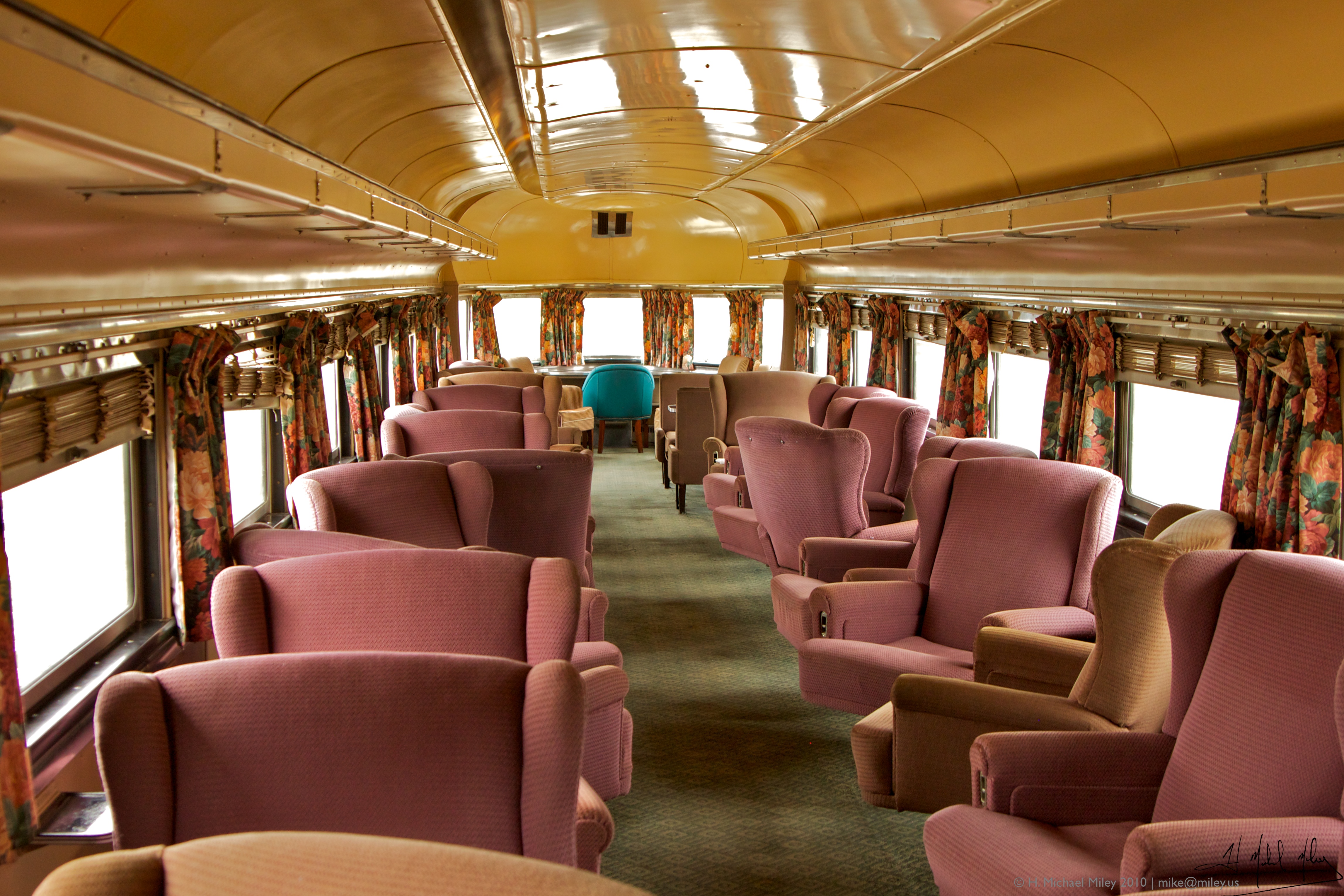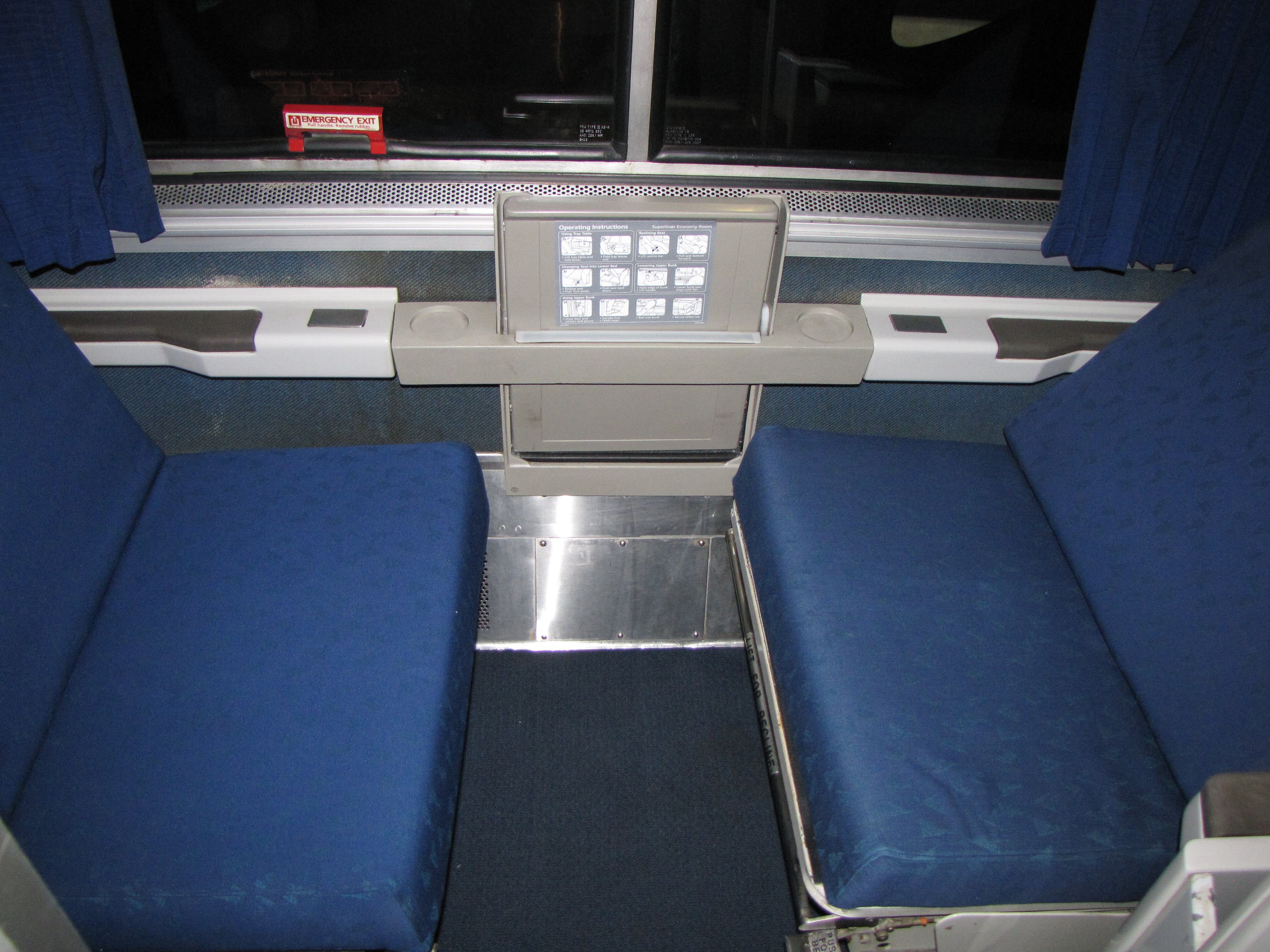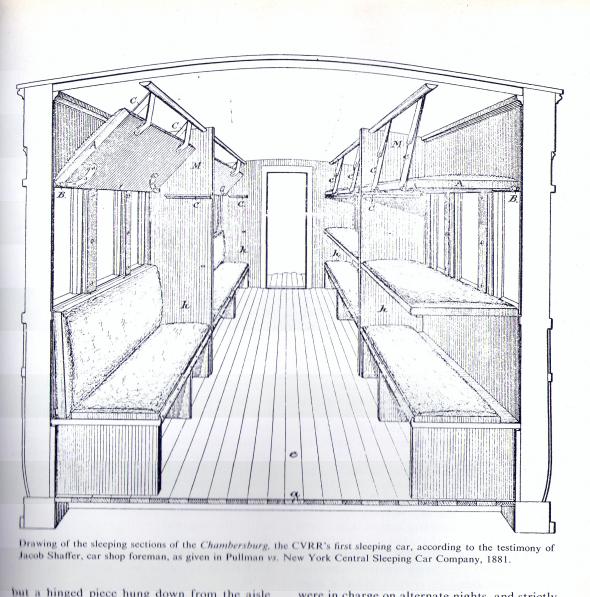|
Twinette
A twinette is a sleeping-berth compartment for two persons in a train. The term "twinette" is in common use only in Australia and New Zealand (unlike "roomette", which originated in North America and is more widespread); thus the double-berth compartments described here are those found in trains in Australia or New Zealand. The width of each twinette compartment is typically almost as great as the width of the sleeping car it is in, with a corridor (occupying the remaining width) running down one side of the car. The number of twinettes in a sleeping car can vary slightly, but it is commonly 8, 9, or 10. The two beds in a twinette are one on top of the other in double-bunk arrangement, and both fold into the front or rear wall of the compartment when not in use, and two seats fold into position in the same area as the berths. Thus the beds are perpendicular to the side of the train, in contrast to roomette berths, which are parallel to it. Twinettes often have their own sho ... [...More Info...] [...Related Items...] OR: [Wikipedia] [Google] [Baidu] |
First Class Travel
First class is the most luxurious and most expensive travel class of seats and service on a train, passenger ship, airplane, bus, or other system of transport. Compared to business class and economy class, it offers the best service and most comfortable accommodation. Aviation The first-class section of a fixed-wing jet airliner is typically toward the front of the aircraft. Many airlines have removed first class altogether from their international flights, offering business class as their highest level of international service. First class passengers are usually allowed into lounges at airports while they wait for their flights. Railways While first-class travel accommodation is common in intercity public transport rail services, they have become increasingly prevalent for commuters' short-distance daily travel, especially in rapid transit contexts, rather than longer-distance regional rail. Australia Australia has internal rail operations in each of its states, excl ... [...More Info...] [...Related Items...] OR: [Wikipedia] [Google] [Baidu] |
Roomette
A roomette is a type of sleeping car compartment in a railroad passenger train. The term was first used in North America, and was later carried over into Australia and New Zealand. Roomette rooms are relatively small, and were originally generally intended for use by a single person; contemporary roomettes on Amtrak, however, include two sleeping berths. By country Australia In Australia, a roomette is designed for use by one person. The width of each compartment is typically slightly less than half the width of the sleeping car it is in, with a corridor running down the centre and the compartments on both sides. The number of roomettes in a sleeping car can vary slightly, but it is commonly 16, 18, or 20. The bed in a roomette folds into one of the end walls of the compartment when not in use, and a seat folds upwards to replace it. Thus the bed is parallel to the side of the train, in contrast to twinette berths, which are perpendicular to it. Because of the narr ... [...More Info...] [...Related Items...] OR: [Wikipedia] [Google] [Baidu] |
Roomette
A roomette is a type of sleeping car compartment in a railroad passenger train. The term was first used in North America, and was later carried over into Australia and New Zealand. Roomette rooms are relatively small, and were originally generally intended for use by a single person; contemporary roomettes on Amtrak, however, include two sleeping berths. By country Australia In Australia, a roomette is designed for use by one person. The width of each compartment is typically slightly less than half the width of the sleeping car it is in, with a corridor running down the centre and the compartments on both sides. The number of roomettes in a sleeping car can vary slightly, but it is commonly 16, 18, or 20. The bed in a roomette folds into one of the end walls of the compartment when not in use, and a seat folds upwards to replace it. Thus the bed is parallel to the side of the train, in contrast to twinette berths, which are perpendicular to it. Because of the narr ... [...More Info...] [...Related Items...] OR: [Wikipedia] [Google] [Baidu] |
Berth (sleeping)
A berth is a bed or sleeping accommodation on vehicles. Space accommodations have contributed to certain common design elements of berths. Beds in boats or ships While beds on large ships are little different from those on shore, the lack of space on smaller yachts means that bunks must be fit in wherever possible. Some of these berths have specific names: ;V-berth: Frequently yachts have a bed in the extreme forward end of the hull (usually in a separate cabin called the forepeak). Because of the shape of the hull this bed is basically triangular, though most also have a triangular notch cut out of the middle of the aft end, splitting it partially into two separate beds and making it more of a V shape, hence the name. This notch can usually be filled in with a detachable board and cushion, creating something more like a double bed (though with drastically reduced space for the feet; 12" wide is typical). The term "V-berth" is not widely used in the UK, instead the cabin a ... [...More Info...] [...Related Items...] OR: [Wikipedia] [Google] [Baidu] |
Australia
Australia, officially the Commonwealth of Australia, is a Sovereign state, sovereign country comprising the mainland of the Australia (continent), Australian continent, the island of Tasmania, and numerous List of islands of Australia, smaller islands. With an area of , Australia is the largest country by area in Oceania and the world's List of countries and dependencies by area, sixth-largest country. Australia is the oldest, flattest, and driest inhabited continent, with the least fertile soils. It is a Megadiverse countries, megadiverse country, and its size gives it a wide variety of landscapes and climates, with Deserts of Australia, deserts in the centre, tropical Forests of Australia, rainforests in the north-east, and List of mountains in Australia, mountain ranges in the south-east. The ancestors of Aboriginal Australians began arriving from south east Asia approximately Early human migrations#Nearby Oceania, 65,000 years ago, during the Last Glacial Period, last i ... [...More Info...] [...Related Items...] OR: [Wikipedia] [Google] [Baidu] |
New Zealand
New Zealand ( mi, Aotearoa ) is an island country in the southwestern Pacific Ocean. It consists of two main landmasses—the North Island () and the South Island ()—and over 700 smaller islands. It is the sixth-largest island country by area, covering . New Zealand is about east of Australia across the Tasman Sea and south of the islands of New Caledonia, Fiji, and Tonga. The country's varied topography and sharp mountain peaks, including the Southern Alps, owe much to tectonic uplift and volcanic eruptions. New Zealand's capital city is Wellington, and its most populous city is Auckland. The islands of New Zealand were the last large habitable land to be settled by humans. Between about 1280 and 1350, Polynesians began to settle in the islands and then developed a distinctive Māori culture. In 1642, the Dutch explorer Abel Tasman became the first European to sight and record New Zealand. In 1840, representatives of the United Kingdom and Māori chiefs ... [...More Info...] [...Related Items...] OR: [Wikipedia] [Google] [Baidu] |
North America
North America is a continent in the Northern Hemisphere and almost entirely within the Western Hemisphere. It is bordered to the north by the Arctic Ocean, to the east by the Atlantic Ocean, to the southeast by South America and the Caribbean Sea, and to the west and south by the Pacific Ocean. Because it is on the North American Plate, North American Tectonic Plate, Greenland is included as a part of North America geographically. North America covers an area of about , about 16.5% of Earth's land area and about 4.8% of its total surface. North America is the third-largest continent by area, following Asia and Africa, and the list of continents and continental subregions by population, fourth by population after Asia, Africa, and Europe. In 2013, its population was estimated at nearly 579 million people in List of sovereign states and dependent territories in North America, 23 independent states, or about 7.5% of the world's population. In Americas (terminology)#Human ge ... [...More Info...] [...Related Items...] OR: [Wikipedia] [Google] [Baidu] |
Sleeping Car
The sleeping car or sleeper (often ) is a railway passenger car that can accommodate all passengers in beds of one kind or another, for the purpose of sleeping. George Pullman was the American innovator of the sleeper car. The first such cars saw sporadic use on American and English railways in the 1830s; they could be configured for coach seating during the day. History Possibly the earliest example of a sleeping car (or ''bed carriage'', as it was then called) was on the London & Birmingham and Grand Junction Railways between London and Lancashire, England. The bed carriage was first made available to first-class passengers in 1838. In the spring of 1839, the Cumberland Valley Railroad pioneered sleeping car service in America with a car named "Chambersburg", between Chambersburg and Harrisburg, Pennsylvania. A couple of years later a second car, the "Carlisle", was introduced into service. [...More Info...] [...Related Items...] OR: [Wikipedia] [Google] [Baidu] |
Perpendicular
In elementary geometry, two geometric objects are perpendicular if they intersect at a right angle (90 degrees or π/2 radians). The condition of perpendicularity may be represented graphically using the ''perpendicular symbol'', ⟂. It can be defined between two lines (or two line segments), between a line and a plane, and between two planes. Perpendicularity is one particular instance of the more general mathematical concept of '' orthogonality''; perpendicularity is the orthogonality of classical geometric objects. Thus, in advanced mathematics, the word "perpendicular" is sometimes used to describe much more complicated geometric orthogonality conditions, such as that between a surface and its '' normal vector''. Definitions A line is said to be perpendicular to another line if the two lines intersect at a right angle. Explicitly, a first line is perpendicular to a second line if (1) the two lines meet; and (2) at the point of intersection the straight angle on one sid ... [...More Info...] [...Related Items...] OR: [Wikipedia] [Google] [Baidu] |
Parallel (geometry)
In geometry, parallel lines are coplanar straight lines that do not intersect at any point. Parallel planes are planes in the same three-dimensional space that never meet. ''Parallel curves'' are curves that do not touch each other or intersect and keep a fixed minimum distance. In three-dimensional Euclidean space, a line and a plane that do not share a point are also said to be parallel. However, two noncoplanar lines are called '' skew lines''. Parallel lines are the subject of Euclid's parallel postulate. Parallelism is primarily a property of affine geometries and Euclidean geometry is a special instance of this type of geometry. In some other geometries, such as hyperbolic geometry, lines can have analogous properties that are referred to as parallelism. Symbol The parallel symbol is \parallel. For example, AB \parallel CD indicates that line ''AB'' is parallel to line ''CD''. In the Unicode character set, the "parallel" and "not parallel" signs have co ... [...More Info...] [...Related Items...] OR: [Wikipedia] [Google] [Baidu] |
Economy Class
Economy class, also called third class, coach class, steerage, or to distinguish it from the slightly more expensive premium economy class, standard economy class or budget economy class, is the lowest travel class of seating in air travel, rail travel, and sometimes ferry or maritime travel. Historically, this travel class has been called tourist class or third class on ocean liners. Marine Travel classes originated from a distinction between "cabin class" and "steerage" on sailing vessels in the 18th century. Cabin class, for wealthier passengers included small cabins and a shared dining room while "steerage" provided open decks with bunks often near the tackle to operate the Steer rudder in converted cargo space on the "between decks" area where passengers from poorer backgrounds cooked their own meals. With the arrival of steamships, competition between ocean liner companies led some companies like the Inman Line to offer additional options to economy passengers seeking to ... [...More Info...] [...Related Items...] OR: [Wikipedia] [Google] [Baidu] |
Sleeping Car
The sleeping car or sleeper (often ) is a railway passenger car that can accommodate all passengers in beds of one kind or another, for the purpose of sleeping. George Pullman was the American innovator of the sleeper car. The first such cars saw sporadic use on American and English railways in the 1830s; they could be configured for coach seating during the day. History Possibly the earliest example of a sleeping car (or ''bed carriage'', as it was then called) was on the London & Birmingham and Grand Junction Railways between London and Lancashire, England. The bed carriage was first made available to first-class passengers in 1838. In the spring of 1839, the Cumberland Valley Railroad pioneered sleeping car service in America with a car named "Chambersburg", between Chambersburg and Harrisburg, Pennsylvania. A couple of years later a second car, the "Carlisle", was introduced into service. [...More Info...] [...Related Items...] OR: [Wikipedia] [Google] [Baidu] |




.jpg)
.png)

